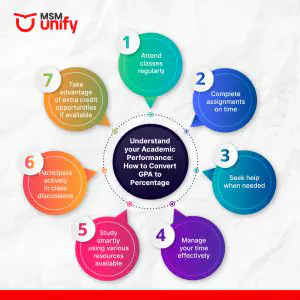Understanding the various grading systems prevalent in different countries takes a lot of work, especially for students who wish to study abroad. Some commonly asked questions include what GPA stands for, what is a bad GPA, and how to convert GPA to percentage. This process is crucial because different universities and employers in various countries may use distinct scales to assess one’s performance.
Whether you’re applying for scholarships, seeking admission to universities, or simply curious about where you stand academically, understanding how to calculate your percentage from GPA is essential knowledge. In this blog, we’ll break down the process step by step, demystify the difference between GPA and percentage, and provide some valuable tips on maintaining a stellar academic record. So grab your calculators and get ready to dive into the world of GPA conversions!
Understanding the difference between GPA and Percentage
When it comes to academic grading, there are two common systems used worldwide: Grade Point Average (GPA) and Percentage. While both methods assess a student’s performance, they differ in their calculation and representation. Thus, to convert GPA to Percentage, you first need to understand the difference between the same.
GPA is a numerical value calculated on a scale of 0 to 4 or 5, depending on the grading system adopted by the educational institution. It takes into account not only the final grades but also factors such as credit hours or course weights. This means that students who excel in challenging courses can earn higher GPAs.
On the other hand, Percentage represents the proportion of correct answers out of total questions attempted. It is expressed as a percentage with 100 being the maximum score achievable. Unlike GPA, percentage does not consider factors like difficulty level or credits earned.
Maintaining a good GPA and percentage requires consistent effort throughout your academic journey. Here are some tips:
By understanding the difference between GPA and Percentage and knowing how to convert them accurately, you can navigate through various educational systems seamlessly while showcasing your achievements effectively!
Why Convert GPA to Percentage?
- University applications: Many universities, particularly outside the U.S., require percentage scores for admission. They might not be familiar with the GPA system or might have a specific requirement stated in percentage terms.
- Scholarship applications: Some scholarships have eligibility criteria based on percentage scores rather than GPA.
- Employment: Employers in certain countries prefer percentage scores to evaluate candidates’ academic performance.
How to calculate GPA?
GPA, or Grade Point Average, is a numerical representation of your academic performance in high school or college. It serves as a standardized way to measure and compare students’ achievements. But how exactly is GPA calculated? Percentage to GPA 10 scale calculation is easier than you would imagine.
The process begins by assigning each grade a numerical value known as a “grade point.” In most systems, grades are typically given on a scale from A to F, with A being the highest and F representing failure. These letter grades are then converted into their corresponding grade points.
Once you have assigned grade points to each of your classes, you can calculate your GPA by averaging these values. The specific method for computing GPA may vary depending on the grading system used by your institution. Check out the GPA Scale table:
|
Letter Grade |
Grade Points | Numerical Grade |
| A+ | 4 GPA |
97–100 |
|
A |
4 GPA | 94–96 |
| A- | 3.75 GPA |
90–93 |
|
B+ |
3.3 GPA | 87–89 |
| B | 3 GPA |
84–86 |
|
B- |
2.75 GPA | 80–83 |
| C+ | 2.3 GPA |
77–79 |
|
C |
2 GPA | 74–76 |
| C- | 1.7 GPA |
70–73 |
|
D+ |
1.3 GPA | 67–69 |
| D | 1 GPA |
64–66 |
|
D- |
0.7 GPA | 60–63 |
| F | 0 GPA |
0–59 |
How to convert GPA to Percentage?
Calculating the percentage from GPA is a common task for students who need to convert their grades into a more familiar format. While GPAs are widely used in educational systems, some institutions or job applications may require a percentage grade instead. Here’s how you can calculate it:
Determine the maximum possible GPA and multiply it by 100. For example, if your school uses a 4-point scale, the maximum GPA would be 4. Multiply this by 100 to get 400.
Next, divide your GPA by the maximum possible GPA and then multiply that result by 100. For instance, if your current GPA is 3.2 GPA on a scale of 4, divide it by 4 and then multiply the quotient (0.8) by 100.
After performing these calculations, you will obtain the percentage equivalent of your GPA. In this case, it would be equal to an impressive score of 80%. Remember that different scales may have varying conversion methods; therefore, make sure to check with your institution or employer for any specific guidelines or requirements they might have.
Most common challenges: GPA to Percentage converter
- Inconsistent conversion methods: The absence of a general procedure for converting the scale of the measurement can confuse you. To address this, make use of the specific conversion method advocated by the particular institution of your choice.
- Different grading scales: Various nations employ different grading systems (e.g. 4.0, 5.0, 10.0). It is also important to know whether your institution uses a standard grading scale or not and if so, convert accordingly.
- Misinterpretation of scores: If the grading system is not properly converted, it may be easily misunderstood when interpreting the GPA. When using a conversion method, make sure to describe your method clearly in your application so that there is no confusion.
- Varying definitions of excellence: The performance of an average student in one country may not be the same as that of an excellent student in another country. Find out the academic requirements of the target country to avoid stretching yourself too thin.
It’s important to note that individual colleges and universities may have unique policies regarding GPAs and percentage conversions. Always check with your institution’s guidelines for accurate information. Converting GPA to percentage will be easy for you now!





























